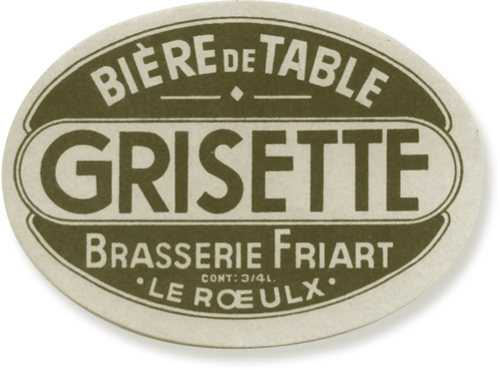
Beer is a product of agriculture, but it has long been removed from the daily operation of the farm. This wasn’t always so. Centuries ago, farms across Europe regularly maintained their own small breweries. They could turn their grain—barley, of course, but also wheat, oats, spelt, and buckwheat—into beer. They might have also used spices, honey, or fruit—whatever was on hand. When beer became an industrial product, it lost that link between land and glass. In fact, modern megabreweries have evolved into chemical plants where malt and hops are combined in a precise process that turns out vats of molecularly consistent beer (they’re often run by chemists, too).
Rustic ales are throwbacks to that earlier time. They are to industrial lagers what farm-fresh raw milk is to pasteurized skim. Breweries are rarely still situated on farms, but when they want to make rustic ales, they use ingredients the way old farmer-brewers did. Saisons are the charter members of the club, but not the only rustic beers out there. With the rise of organic brewing, an emphasis on local ingredients, and a return to traditional brewing methods, rustic ales are one of the success stories of twenty-first–century brewing. ■
THE STORY OF most beer styles is evolution. From an early period when brewers labored on primitive equipment, a style developed in fits and starts with each new technological breakthrough. Rustic ales are a study in preservation. The original saisons and country ales were rustic by necessity and they stayed that way by neglect or stubbornness until almost disappearing in the 1960s. Now breweries have to make an effort, with their precision-calibrated machines and refined ingredients, to recapture the essence that once defined all beer.
For most of its long history, brewing was a domestic chore. Breweries were extensions of the work of a farm, and beer was just one of the ways people converted their labor into sustenance. This changed very slowly, first with the rise of monastic breweries in the seventh or eighth century and then with the gradual commercialization of brewing in cities in the following centuries. As commercial trade increased and beer became more readily available, country brewing went into decline. The Industrial Revolution hastened this, and country brewing continued on in only small pockets in northeastern France, Belgium’s Wallonia, and Fraconia in Germany.

When French and Belgian Farmhouse Ales Parted Ways. If you happen to drive in Belgium from Watou, in West Flanders, to Pipaix, in Hainaut, you take a short jot south to the E42 and spend most of the drive in France. It’s not obvious where the line is as you zip through the undifferentiated European Union. This is a return to the past, for the two regions on either side of the current Belgian border share a lot of culture and history.
Beer is one part of that shared heritage, and the greatest density of French breweries is in the Nord-Pas-de-Calais region, immediately next to its neighbor, the saison-brewing Belgian Hainaut. The French region is also famous for farmhouse brewing and its own farmhouse style—bière de garde. Yet as full of rustic charm as saisons are, bières de garde are refined and polished. What happened?
In a word: war. As recently as the early 1900s, bière de garde was being described in terms that sound a lot like Belgian saisons, as a vat-aged beer “purposely allowed to become acid, and at the same time acquiring a vinous flavour.” (From an account by R. E. Evans in 1905.) The First World War however, decimated French brewing. Many of the buildings themselves were damaged in the fighting, brewing stalled, and due to the loss of life, the customer base shrank 25 percent. Few breweries returned after the war and they didn’t brew the tart, rustic prewar bière de garde. Like so many other countries, France turned to lagers; surviving northern ale breweries made beers to compete with those lagers—soft, rounded, and easy-drinking. When bière de garde started to sell again in the 1970s, the style had more in common with bocks or Scottish ales than the saisons just across the border. Far from rustic, they had become satiny, smooth beers lagered for refinement (and sometimes made with lager yeast).
Bières de garde and saisons are routinely clumped together as “farmhouse ales,” but it’s misleading. While they share a common ancestor, they have become very different styles. Belgian farmhouse ales suffered from the wars, too, but the lineage was never completely broken. Belgium retained a taste for rustic ales.
Brewing wasn’t a well-documented profession, even where it was done professionally. Records of country brewing are almost nonexistent before the nineteenth century, so we know nothing about the types of beers farmers made, how they made them, or what they were made of beyond what we can infer from commercial breweries at the time. The first real records come from the mid-1800s. Saisons and rustic ales of that era were brewed by farmers on primitive equipment—their own, in the case of big farms, or communal brewing facilities shared by smaller farms. Brewing in the fall and spring, farmers made beers that would nourish them through the winter and slake their thirsts in the summer. The spent grains were reused as food for their animals.
The beers themselves were made with ingredients a farmer could access, usually grists made out of multiple grains. In addition to barley, wheat and oats were very common; spelt—a key ingredient of the saisons of Liège—was somewhat common; and buckwheat was an occasional ingredient. Farmers malted their own grain, producing inconsistent, poorly modified malt. Poor malting techniques resulted in that “rustic” character—in this case, a sometimes acrid, sharp, or even harsh beer. Beyond the malt, local hops were also described as “biting,” and fermentation varied greatly as well. The addition of wheat and oats had the benefit of smoothing and softening those spikier elements.
It’s easy to romanticize wholesome farmhouse ales, but these were amateur brewers making beer on wheezy, rusty, old equipment a few times a year—a lot of that beer would have been pretty gnarly stuff. Adding spices was another measure toward remediating harshness. Ginger was a mainstay, and nineteenth-century writers mention star anise, sage, peppercorn, coriander, and cumin as regular spices.
Yeast character was and remains the central element in these beers. Belgian brewers were the slowest to adopt modern wort-chilling techniques, and well into the twentieth century were still putting their hot wort in flat, panlike vats (cool ships) to cool overnight. As the wort cooled, wild airborne yeasts would settle on its surface. Although brewers pitched yeast in the morning, by then the damage was done—their beer had become inoculated with souring microorganisms that would quickly turn them tart. (This is still how lambics are made.) All old farmhouse ales were soured. The effect was less pronounced in the table beers, as they were served within a week or two of brewing, but stronger stuff that had aged for months or years in the cellar had the wild, sour character of lambic.
In the decades following Louis Pasteur’s identification of yeast in the 1850s, early microbiologists helped breweries manipulate their strains so they could produce more consistent, reliable beer that didn’t spoil. Within a few decades, wild yeasts had largely been eliminated in Britain. Belgian brewers liked the character untamed yeast gave to their beers, however, and some breweries nurtured their old strains. They mostly abandoned cool ships (eventually), but continued to pitch house yeasts that were not fully domesticated.
Modernity caught up to the farmer-brewers in the twentieth century. After the world wars, there were almost none left. Some farmers abandoned brewing, and some abandoned farming, becoming brewers as the market landscape favored specialization. By the 1950s, most of the rustic styles were dead or dying.
Nineteenth-century farmhouse ales were all relatively weak, but after the Second World War, breweries started producing stronger bottled beers they labeled saisons (a term previously used for only one type of Wallonian beer). These were the descendants of the aged farmhouse ales, but their reputation was different. German lagers and British ales had come into the Belgian market, driving a trend toward quality and strength. Modern saisons were dry and complex—and popular in French-speaking Belgium. They were no longer associated with the farm but with quality—and were packaged in Champagne-style bottles as a signal to consumers.
Their moment didn’t last long. By the 1970s, all the old-time rustic Belgian ales had vanished—the Leuven wheat ales, the Peetermans, the uytzets (see page 247). The living lines of true rustic ales existed at just a few breweries like Dupont and Silly, and even there they had become small niche styles. Fortunately, they didn’t die out. Foreign interest in Dupont brought new attention to the style in the 1970s and ’80s, and revival breweries committed to old-school rustic ales started cropping up throughout Wallonia. Rustic ales still remain very much a niche species within the Belgian ecosystem, but one that has happily been taken off the endangered list. ■
RUSTIC ALES WERE never brewed in a consistent style. They were made in ways that conformed to the very specific circumstances of a farmhouse brewery—which varied farm to farm. Modern rustic ales are much more coherent, and saisons in particular have fairly clear contours. How did this happen? Brasserie Dupont. There may be no other brewery more synonymous with a single style or more responsible for its existence.
As recently as the mid-1980s, it was a perfectly preserved brewery that might have been beamed in from the 1880s. Still a working farm dating to 1759, Dupont malted its own grain until 1986, used a mash tun that dated to before 1844 (when the brewery was added), fired its kettle with an open flame, and pitched yeast dating back to at least the 1920s. It must have been like stepping back in time.
The beer is, if anything, even more astounding. Belgian beer expert Tim Webb—a man generally given to understatement—said, “While there is no such thing as the best beer in the world, if there was, it might be Saison Dupont.” The beer is bottled joy, a buoyant orange that feeds a bubbling snowy head. The nose has deep herbal and earthy qualities but also summer fruits that lift off the fizzing surface. One wants to use the word “complex” carefully here, because the presentation is refreshing and effortless; however, a careful study reveals a spine of minerality (from both the carbonation and hard well water), the suggestion of caramel in the grain-y malt base, a surprising depth of spicy hopping, and a mile-long dry finish. Saisons were once made to quench thirsts, and few beers in the world can match a well-made saison in that regard.
Saisons have multiplied in Wallonia, where Blaugies, Fantôme, Vapeur, Lefebvre, Jandrain-Jandrenouille, Ecaussinnes, Ellezelloise, and tiny Cazeau have joined Silly and Dupont—though they remain hard to find, even in Belgium. Where rustic ales have really taken off is the United States, which now produces a number of exceptional examples.
Not surprisingly, Belgians and Americans have their own takes on the style. The word “rustic” comes almost unchanged from the Latin and it refers to the countryside. In Belgium, they take this literally, and many of the producers are located in historic farmhouses. With rare exceptions, Americans put the country in their saisons, rather than situating the breweries in the country. Belgian breweries are more inclined toward spices but less toward hops. Americans, of course, love them some hops. Breweries from both countries have experimented with wild yeasts, but Americans more so.
Rescuing Saison. The saison style had dwindled to near nonexistence by the 1970s. Brasserie de Silly made one and Dupont made one. Neither brewery depended on them. The saison had a tiny following and Dupont’s future seemed to be with Moinette, a robust pale ale. When writer Michael Jackson began poking around Belgium in the 1970s looking for lost treasures, he discovered saisons and raved about them. For the first time, an English-speaking audience learned of their existence. He prevailed upon American importers to have a look at this obscure little style and, fortunately, Don Feinberg of Vanberg & Dewulf listened.
“When I did get to [Dupont], they told me that they wanted us to import Moinette,” Feinberg recalls. “I told them that ‘that’s a great beer, but the beer that I really am interested in is Saison Dupont.’ They proceeded to tell me that they were actually thinking of discontinuing Saison Dupont, which at that point was down to 2 percent of their sales.” Feinberg encouraged Dupont to change the packaging, and then set off to sell it in the U.S. For those who love rustic ales, it was a pivotal moment.
Export to the United States (and later, other countries) not only saved Dupont’s brand, but quite likely the style. Saisons remain a tiny niche in Belgium—and even at Dupont things haven’t entirely changed. Olivier Dedeycker, one of the family owners and the brewer, told me that in Belgium, “when you speak of Brasserie Dupont, it’s Moinette. A lot of people in Belgium don’t know Saison Dupont.” Saison Dupont is the flagship, sort of, but relies almost entirely on foreign export, which constitutes 40 percent of the brewery’s output.
It’s one of the more remarkable stories in brewing. Dupont has become a legendary brewery, easily one of the handful that most influenced American brewers. In the United States, saisons have moved from a weird fringe style to—well, to a less fringe, slightly more mainstream style. Lots more are brewed in America than in Belgium, though. Yet like the Pixies and Velvet Underground, who created revolutionary music that inspired far more successful bands like Nirvana and REM, few breweries have a greater status among their peers than tiny Brasserie Dupont.
On both sides of the Atlantic, saisons have certain characteristics that distinguish them from other beers. Rare is the saison with all of these elements, but the goal is to use them as a way of signaling the beer’s rustic heritage.
■ Interesting grain character, which could mean a wheaty softness, a silkiness from oats, or the nuttiness of spelt. Originally these beers were made with rougher grain not optimized for beer brewing. These beers shouldn’t taste perfectly smooth and refined, like factory white bread; they should have some flavor and texture, like a handmade loaf of whole grain.
■ A hazy appearance, which might come from grains or starches, hop matter, or yeast. When breweries started to be able to make perfectly clear (“bright”) beers, it was a signal to the customer that there were no infections or quality problems. A bit of haze suggests handmade ales of the age before filtering.
■ A spiciness, which may derive from actual spices or from hops and fermentation. If spices are used, they shouldn’t dominate the beer. Rustic ales should be refreshing, not sweet, herbal stews.
■ A crisp, refreshing dryness. Rustic ales were originally the farmer’s session beer, so they couldn’t be very rich or heavy. Effervescence, minerality, hops, and/or yeast character may figure into the equation. Most saisons have a thin, vinous character that comes from their highly attenuative yeasts.
■ Pronounced yeast character. This is the most important quality in a rustic ale and it’s really nonnegotiable. “Rustic” can almost be read as code for untamed yeasts and the wild, fruity, or spicy compounds they produce.
Saisons aren’t the only rustic ales in Belgium. It was the only style to survive the farmhouse era intact, but breweries haven’t forgotten older traditions. Rusticity is a continuum, and it touches many beers not officially called saisons. A brewery may use an interesting grain, like Brasserie Silenrieux, located halfway between Charleroi and Chimay. Founder Eric Bedoret was fascinated with heritage grains like buckwheat and spelt and wondered if it was possible to brew with them. Working with professors at the University of Louvain, Bedoret came up with recipes for Sara, the buckwheat ale, and Joseph, a spiced spelt witbier. Sara has an unexpected combination of flavors—tobacco, currant, and light acidity—while Joseph is lemony and herbal. They hint at what beer might have tasted like when it came straight off the farm.
Brouwerij Kerkom (“Bink” on the bottles), just twenty-five miles from Maastricht in the east of Belgium, is another brewery that borrows heavily from old traditions. Its five beers are all made traditionally and have definite farmhouse touches. Bink Bloesem is brewed in the summer with local honey and pear syrup; Adelardus, named for a local abbot, uses sweet gale. But the most interesting is Bink Blond, which has a pretty straightforward recipe (it lacks the honey, pear, or sweet gale). The character of this beer is pure farmhouse. With a cloudy amber body, herbal hopping, and a spicy, acidic yeast character, it reminds me of the nineteenth-century beers described in the history books.
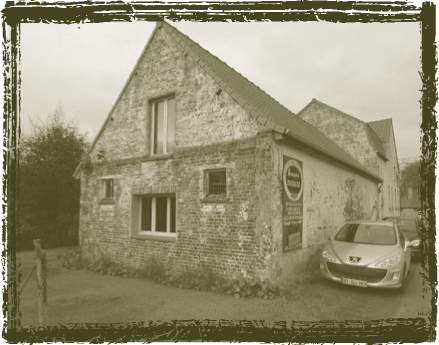
The evocative little building where Daniel Thiriez of the eponymous Brasserie Thiriez makes his rustic ales in Esquelbecq, France
If you start looking around, you’ll see touches of rusticity in many goblets. Orval, brewed the same way for more than eighty years, uses whole-leaf hops and a blend of yeasts including Brettanomyces. Bosteels’s Tripel Karmeliet is a glitzy beer one would have a hard time calling rustic, yet the recipe is a throwback to a seventeenth-century ale made with wheat, oats, and spices. At Brasserie Caracole, they brew their rustic beers over an open wood-fired flame. Because rusticity can be accessed through so many different methods, the world of farmhouse ales extends beyond the group we call saisons. ■
MORE THAN MOST styles, saisons and rustic ales get their character from process rather than ingredients. Not that ingredients aren’t important—the use of multigrain grists and spices helps define them. But those old-timey flavors that breweries nurture emerge more from the way the beer is handled than what goes in it.
In Belgium, it is easier for breweries to have access to older equipment like kettles fired by an open flame. For Saison Dupont, the hot spots created by the flame caramelize the wort, producing the beer’s characteristic orange color and contributing a light toffee flavor. Modern American breweries typically don’t use open flames, so they compensate with darker grains. This may produce roughly similar colors, but the flavors taste layered rather than integrated. Specialty malts have their own flavors, and they’re not the same as those that come from direct fire. Similarly, Belgian water is hard, and this lends a stiffness to their beers. Brewers elsewhere may prefer a softer profile, but some, particularly when they’re imitating Dupont, amend their water.
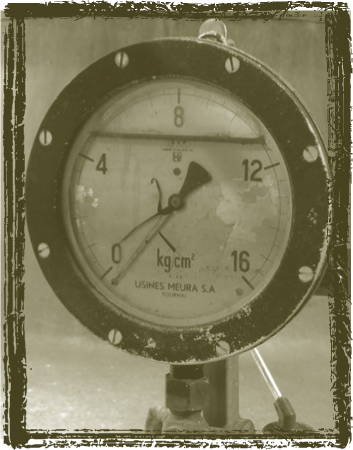
As evinced by this gauge at Brasserie Dubuisson, in Belgium, breweries do not replace equipment just because it’s old.
Mashing techniques are fairly standard, though breweries use low temperatures to maximize fermentability and reduce body—important when using finicky farmhouse yeast strains. The hallmark of this style of brewing is warm fermentation; indeed, when a Belgian brewery describes its process as “high fermentation,” they mean temperature—and are signaling the use of rustic yeast strains. Warm fermentation is critical to the development of rustic beer’s signature ester and phenol compounds. American breweries are often leery about letting the temperatures rise too high during fermentation, but this was the tradition before tanks were fitted with glycol chillers. The yeasts can handle temperatures in the seventies and eighties (and Dupont’s is fine up to 100°F) and cool fermentations will result in smooth beers lacking character.
Other techniques help add rusticity. Old farm breweries didn’t use tall cylindro-conical fermenters. Those vessels repress ester formation; wide fermenters, especially open ones, allow the yeasts to develop more character. Another technique is the use of multiple yeast strains, which also helps develop esters and phenols. Bottled saisons are bottle-conditioned (especially in Belgium) and not filtered. This gives the beer a level of haziness, sometimes subtle, sometimes bordering on murky. All of these techniques influence the flavor of beer. Even something as seemingly minor as laying bottles on their side during bottle-conditioning can have noticeable effects.
In terms of the recipe, there are no rules except that they produce that rustic je ne sais quoi. Spiciness may come from the yeast, the grains, the hops, or actual spices. Fantôme’s Dany Prignon loves to tuck herbs and spices into his saisons (his use of black pepper is especially clever), while other saison brewers eschew them. In Orange County, California, The Bruery’s Tyler King adds a special ingredient to his saison—one most people don’t even realize is there. “One cool little fact is that Saison Rue has spearmint in it. If you take Saison Rue when it’s young, you can taste the mint. But as the beer ages, the mint goes away and the Brettanomyces develops. We didn’t design it this way, but usually by the time you can stop tasting the mint in the beer, it’s ready to be sold. It adds a layer of complexity; you don’t know it’s there unless it’s missing.” Hops, grains, spices, and yeasts are all tools in the saison maker’s tool kit. In no case should any one element overwhelm the others. ■
RUSTIC ALES ARE enjoying one of the least likely revivals in brewing history. Left for dead in the 1980s, by all logic they should have joined a breed of extinct beers that had already departed the Belgian scene. They are exactly the opposite of the kind of beers modern breweries like to brew: The best ones are made on the funkiest, oldest, or just strangest equipment with the trickiest ingredients and a process that begs for inconsistency. Yet here we are, not many decades later, in a world where saisons have become a regular offering by American breweries. Indeed, it’s easier to find a Belgian saison than a German bock at the grocery store.
Grammarians warn of the mistake of “back formation,” where writers take a word and shorten it, thinking they’re taking it back to a more essential, spare root (“gruntle” from “disgruntled,” for example). Americans have this tendency with beer styles, taking some half-understood sense and tweaking it for “greater” authenticity (see Scottish Ales, starting on page 213). But they may have redeemed themselves with saisons. Many American breweries have been deeply inspired by these beers, and they treat saison with loving respect. Not only are some of the best examples in the world being brewed by Americans, but some of the most historically authentic, as well.
“We’re gonna come out with a saison.” In 2011, I wrote an article about the boom in American craft brewery openings. I found myself on the phone with Coby Lake of Avondale Brewing in Birmingham, Alabama. Avondale wasn’t yet open, and the business depended on the state legislature loosening rules passed after Prohibition that made it very hard to start new breweries. The element that might have doomed Avondale was a part of the law that made tasting rooms illegal. Lake—who sounds almost exactly like the actor Walton Goggins (another Birmingham native)—has a gambler’s attitude toward risk. In the background, I heard construction work on a new bar for the brewery—which wasn’t yet legal. (The law passed.)
All of this was fascinating, and it took a while to get around to the beer. When I asked Lake what he planned to brew, I expected the owner of Alabama’s fourth brewery—deep, deep in Bud country—to say a pale or maybe golden ale. Nope. Instead, Walton Goggins drawled over the phone, “We’re gonna come out with a saison; we’re gonna call it Spring Street.” I was amazed.
He wasn’t alone, either. I talked with Paul Nelson of Edwinton, North Dakota’s second brewery, and they were also leading with a saison. Breweries in Texas, Nebraska, and Florida are all brewing them now. When breweries in remote parts of the beer world settle on saisons as their flagships, one has to conclude that the style is obscure no more.
One of the best examples is New York–based, Moortgat-owned Ommegang and their spectacular Hennepin, a beer with yeast complexity rivaled only by Dupont. Or by Boulevard’s Tank 7, another beer that has not only remarkable yeast character, but a malt rusticity provided by corn and wheat—an homage to the crops around the brewery in Kansas City, Missouri. Jolly Pumpkin, Goose Island, and Hill Farmstead all make world-class examples, too.
Where the Untied States really shines, though, is taking saisons back to their true, wild-yeast farmhouse roots. Two breweries stand out. The Bruery makes many Belgian-inflected beers, including two Brettanomyces-inoculated examples, Saison Rue and Saison de Lente. Both use the wild yeast to add balancing elements of drying crispness; in Saison Rue, made with rye, the effect is spicier and more tart. In Corvallis, Oregon, brewery Block 15’s Nick Arzner makes Ferme de la Ville Provision from a blend of young and aged saison, and the wild yeasts add only a drying, quinine-like note that accentuates the malt and primary yeast character.
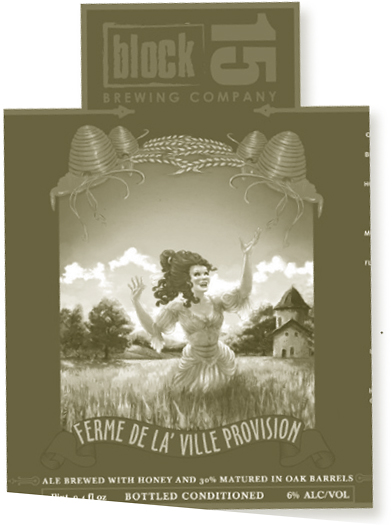
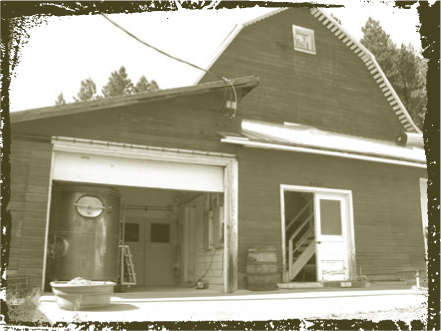
Dave Logsdon, founder of Wyeast Labs, recently opened up his own farmhouse brewery in an actual farmhouse near Hood River, Oregon.
Finally, as beer has begun to slowly insinuate itself onto the tables of some of America’s better restaurants, saisons have been a natural fit. Their profile, dry and crisp, is recognizable to wine sommeliers; their native rusticity also plays nicely in restaurants where chefs relish fresh, farm-to-table simplicity. Saisons are so versatile because they pull out different flavors in different dishes. They highlight sweetness in shellfish, yet complement the bitterness of fresh greens. They are also one of the best beers to pair with cheese. ■
SURVEYING BEERS WITHIN a style usually means looking for hallmarks that define it. With rustic ales and saisons, the process is a bit more elusive; one looks for the spirit of rusticity. Since these ales may be any color or strength, you’re instead looking for qualities that come from pre-industrial methods, not ingredients or national tradition. But never fear, sample a few of these, and that spirit will present itself as mightily as hops in any IPA.

LOCATION: Tourpes, Belgium
MALT: Pilsner
HOPS: Undisclosed
6.5% ABV
Dupont is recognizable from the pop of the cork. It has a kind of vibrance that rouses both a roiling bead and a tall, snowy head. The color is somewhere between a hazy gold and orange, and it looks best in a tall glass or tumbler—something to show off the light and bubbles. Saison Dupont is an evolving beer, and a fresher bottle will have more hop character, particularly on the nose; as it ages, the hops fall back a bit, exposing the beer’s fresh, mineral crispness. The yeast character grows and changes. I’ve had bottles that seemed full of citrus, while others were more peppery or herbal. It’s a beer to befriend and take out to dinner as often as possible; you want to develop a relationship with this ale.
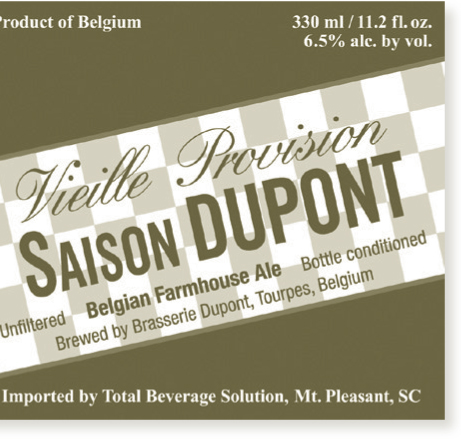

LOCATION: Tourpes, Belgium
MALT: Undisclosed
HOPS: Undisclosed
3.5% ABV
Avril is one of the few examples of a farmhouse bière de table available (though it was only introduced a few years back). It is a masterpiece of beer haiku: Though it has fewer ingredients than its peers, it is remarkably flavorful. Cloudy and effervescent, zesty and well-hopped with earthy, spicy hops, it is as refreshing as a spring morning.

LOCATION: Kerkom-Sint Truiden, Belgium
MALT: Two varieties, undisclosed
HOPS: Challenger, East Kent Golding, Saaz
5.5% ABV, 1.050 SP. GR., 55 EBU
This beautifully misnamed beer is not blond—it’s a hazy amber. It must be shocking to consumers who expect a neutral, sparkling ale to instead find this rustic beer sending off waves of herbal, rosemary hopping. There is also a toffee note and bit of yeasty phenol—definitely not neutral. It’s a highly carbonated beer that keeps aloft a skiff of head as you drink, which is ideal to feed the volatile hop aromas dancing under your nose.

LOCATION: Jandrain-Jandrenouille, Belgium
MALT: Undisclosed
HOPS: Undisclosed
6.5% ABV
I was instantly taken with the first beer from a fairly new brewery to the southeast of Brussels—but it took me half a glass to place it. The key is lychee, which is evident both in the nose and on the tongue. Lots and lots and lots of lychee. It’s a hazy, honey-colored beer with only modest effervescence. The aroma also has touches of floral hopping, and the palate is long and dry, with a touch of quinine and lemongrass. But that lychee lingers through that dry finish, and then even a little while longer.
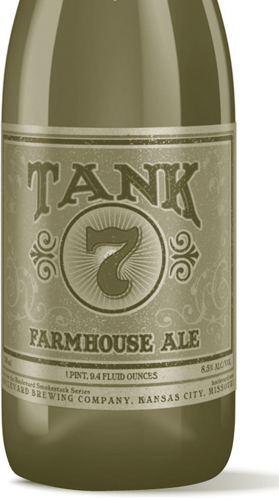

LOCATION: Kansas City, MO
MALT: Pale, malted wheat, unmalted wheat, corn
HOPS: Amarillo, Simcoe, Tradition
8% ABV, 1.071 SP. GR., 38 IBU
Boulevard’s brewer, Steven Pauwels, grew up in his father’s brewery in Belgium. Before arriving at Boulevard, he made beer in the famous brewing city of Leuven and later in Bruges. Beer making is in his blood, and saison is his favorite style. His recipe is an acknowledgment of the farms around Boulevard in Kansas City, even if the brewery is no farmhouse. The wheat and corn provide a soft, lightly sweet malt base that’s as comforting and familiar as a bowl of porridge. The aroma is pure saison, though, with a musty, slightly cellar-like yeast quality. Fermentation provides the white pepper and citrus notes, and they marry perfectly with the light, sweet grain. It’s not as bone-dry as some saisons, but it finishes with a quenching snap.

LOCATION: Cooperstown, NY
MALT: Pale, pilsner, corn
HOPS: Styrian Golding
OTHER: Coriander, sweet orange peel, ginger, grains of paradise, dextrose
7.7% ABV, 1.067 SP. GR., 24 IBU
Brewery Ommegang was one of the first American breweries to release a saison, and they didn’t try to Americanize it. The spicing is subtle, and the ginger in particular works with the modest hopping to create the sensation of stiffer bitterness than the IBU would suggest. It’s difficult to tell where the spices end and the yeast character begins, but they harmonize beautifully.
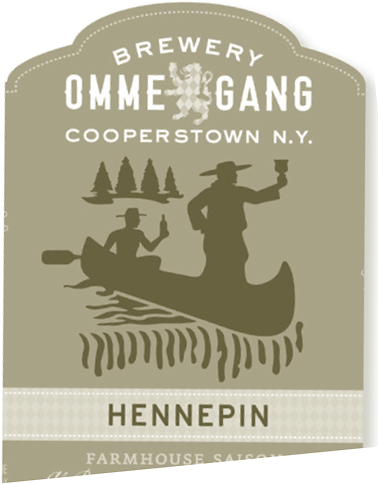

LOCATION: Corvallis, OR
MALT: Pilsner, wheat, oats, rye
HOPS: Golding, Sterling
OTHER: Honey
6.9% ABV, 1.049 SP. GR., 25 IBU
Ferme de la Ville is a blend of three vintages of the beer. Two of the portions are barrel-aged twelve and eighteen months, each constituting about 15 percent of the final beer. The remainder comes from fresh saison. The result is the definition of rustic: a beer full of grain-y complexity (at turns rye-spicy and oat-soft), with tart and refreshing stone fruit notes and a crisp, dry finish. Blending fresh and wild yeast–soured beer takes the edge off Ferme de la Ville; it’s lightly tart and crisp, thirst-slaking like a tall glass of lemonade.

LOCATION: Soy, Belgium
MALT: Undisclosed
HOPS: Undisclosed
OTHER: Undisclosed
8% ABV
Fantôme’s saison, apropos for a rustic ale, has shifted and changed in the nearly two decades I’ve been drinking it. The first time I tried it, it was laced with black pepper and had a tangy phenolic finish. Later it was more cakey but citrusy, and later still more tart and herbal. It has never failed to communicate rustic, and the mutability makes it all the more enticing.

LOCATION: Blaugies, Belgium
MALT: Undisclosed
HOPS: Undisclosed
OTHER: Granulated sugar
8% ABV
Most twenty-first-century saisons tend toward the very pale to light orange—modern colors for farmhouse ales. La Moneuse is a rich amber, recalling the earlier tradition. It’s a beer of amazing effervescence—the mousse-like head never has a chance to recede from the roiling bead. There’s a touch of wild in the beer, almost balsamic, backed by a tannic chicory note. One of the driest saisons available—and that’s saying something for one of the driest styles brewed.

LOCATION: Chicago, IL
MALT: Pale, pilsner, wheat
HOPS: Amarillo
OTHER: Aged in wine barrels with orange peel
6.5% ABV, 20 IBU
Avigorously effervescent, sunny golden beer, Sofie is a nice American take on the style. Hops are gentle but obvious—tropical and warm, picking up wonderful notes from the yeast. It has a bit of wild yeast in it, which elongates the fruits and draws them in a citric direction. The wild yeasts will continue to dry the beer out; the tropical notes give way to a beer that is very dry and vinous.
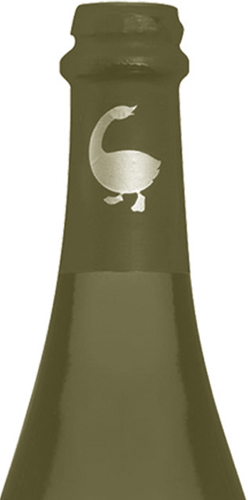
ONE MAKES MANY REMARKABLE DISCOVERIES ON A TOUR OF BRASSERIE DUPONT: THE FLAME-FIRED KETTLE, THE EYE-POPPING FERMENTATION TEMPERATURES, THE RUSTIC PILSNER KNOWN ONLY TO LOCALS. BUT THE ONE THAT MOST AMAZED ME WAS SOMETHING OLIVIER DEDEYCKER TOLD ME AS I WAS ABOUT TO LEAVE: HIS FAMILY’S BREWERY MAKES ONLY ABOUT 13,000 U.S. BARRELS EACH YEAR (AS OF 2012). MORE THAN ANYTHING ELSE, THIS UNDERSCORED THE REALITY THAT DUPONT, EVEN AMID AN EXPANSION THAT WILL BRING TOTAL ANNUAL CAPACITY TO OVER 40,000 BARRELS, REMAINS A SMALL FARMHOUSE BREWERY.
Dupont is located in Tourpes, a tiny farming village nine miles from France in Hainaut province. That region looks like a crazy quilt of farm fields—none square—and Tourpes barely interrupts them. Dupont, itself a farm, is twenty years older than the United States, but the owners “only” took up brewing in 1844. In 1920, Louis Dupont bought the farm and it has remained in the family since. Dedeycker was born into the business. “My parents lived 500 meters from here and my grandfather lived here, so we were always in the brewery. All of my holidays were spent here at the brewery.” He started as brewing engineer in 1990 and took over as brewer from his uncle, the legendary brewer Marc Rosier, in 2002.
Remarkably, Dupont survived essentially unchanged through the mid-1980s, functioning very much as it did a century earlier. In the nineteenth century, farms incorporated brewing into their regular activities, which meant everything was done on-site. That remained true for Dupont, which continued to use its own well water, malted its own barley, and used nineteenth-century equipment to make the beer. (The one update: the kettle, which had to be replaced in 1920 after Germans took the original for the war effort.)
Over the past thirty years, Rosier and Dedeycker updated the brewery very slowly, deciding how to modernize the equipment without changing the beer. In 1986, Rosier discontinued the laborious and dangerous process of malting (fire is a constant problem, and Dupont, like many breweries, got burned), and in 2008 the old mash tun, which dated to before 1844, finally gave out and had to be replaced as well. While making the updates, Rosier and Dedeycker had great instincts about which methods they needed to retain to keep the spirit of the farm alive. There were places the brewery refused to modernize. Dupont still uses hard water straight from the brewery’s well. The minerality contributes a stiffness to the beer’s profile, and Dedeycker has seen no reason to change. He is also a big believer in the direct-fired kettle, and during my visit, he flipped the switch so I could see and hear it roar to life. A flame concentrates heat on the bottom of the kettle and caramelizes the wort, giving Saison Dupont its trademark honey color despite the all-pilsner malt grist.
In the fermentation room, Dupont’s remarkable yeast gobbles maltose in wide, square fermenters. This is the area where Dedeycker seems to take the most care; yeast is the heart of Dupont’s character, and the brewery pays very close attention to how it’s behaving. It may be the most famous yeast in the world, and many people have heard its reputation. During fermentation, yeast generates heat as it becomes active. Almost every brewery on the planet controls this temperature rise. Almost. Dedeycker lets his yeast free-rise as hot as it wants to go, way past where any other yeast would make something roughly as tasty as gasoline. Somehow, though, the Dupont yeast is adapted to blood-warm temperatures—and indeed, without them, the yeast fails to produce the beer’s characteristic spicy, earthy flavors. When I visited, electronic monitors showed the fermenters in a range of stages, from the modest 22°C (70°F—a normal reading) to a robust 35.3°C (96°F). But fear not, on those rare occasions when the fevered yeasts go past 102°F, Dedeycker intervenes to prevent the bacchanal from getting out of hand.
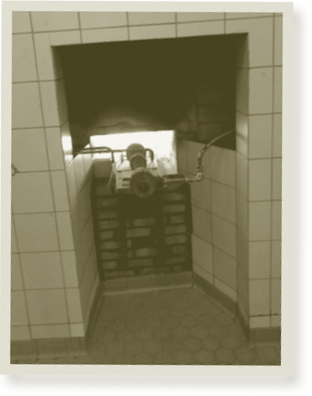
The gas-fired flame roars to life; it is instrumental in caramelizing the wort.
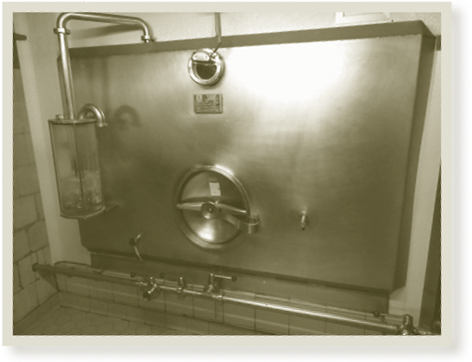
Square fermenters are one more element in Dupont’s yeast-based approach to beer.
The mystique of Dupont’s yeast has captivated brewers for decades. When I asked whether it came from a red wine culture, as some have speculated, Dedeycker grinned and said, “Maybe.” The secret and the yeast are both safe with Dedeycker’s wife—a doctor of microbiology—who tends it in the lab. The brewery is able to re-pitch it for 150 to 200 generations before having to start a new culture (some breweries only reuse yeast for a few generations).
The bottling line, usually a point of only marginal interest, is yet another unexpectedly fascinating part of the brewery. Once bottled, the beers are laid on their side and stored for six to eight weeks in a warm room to finish bottle fermentation. The problem is the bottling line—it leaves the beers standing upright. This seems like it would be of scant consequence, but no. The beer changes depending on whether it conditions while standing up or lying down, a phenomenon Dupont has studied carefully. Standing up “we have a totally different beer. It seems to be only a small thing, but the impact on the taste is really big.”
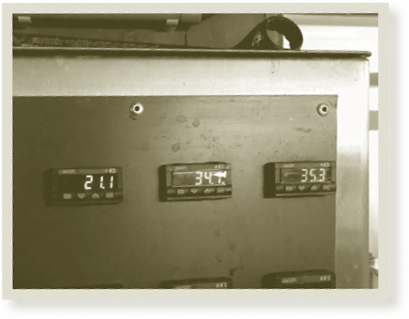
The temperature inside the fermenters (left to right, 70°F, 93.4°F, 95.5°F)
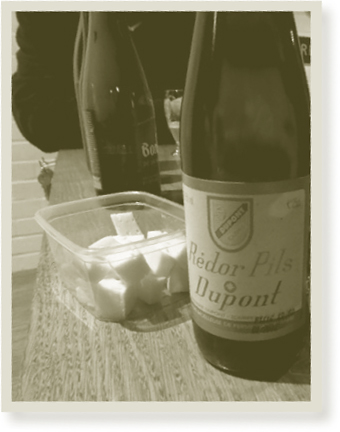
A sample is incomplete without Dupont’s house cheese.
For years, the solution had been for employees to collect the bottles and place them in a crate, lying down. But a month after I visited, Dupont installed a new piece of equipment—a robot that now completes the process in place of people. “We had to wait a long time to be able to buy it,” Dedeycker said. This was a strange but perfectly apt metaphor for Dupont’s evolution: using new equipment and techniques to preserve some of the oldest traditions in brewing.